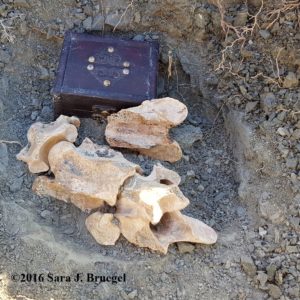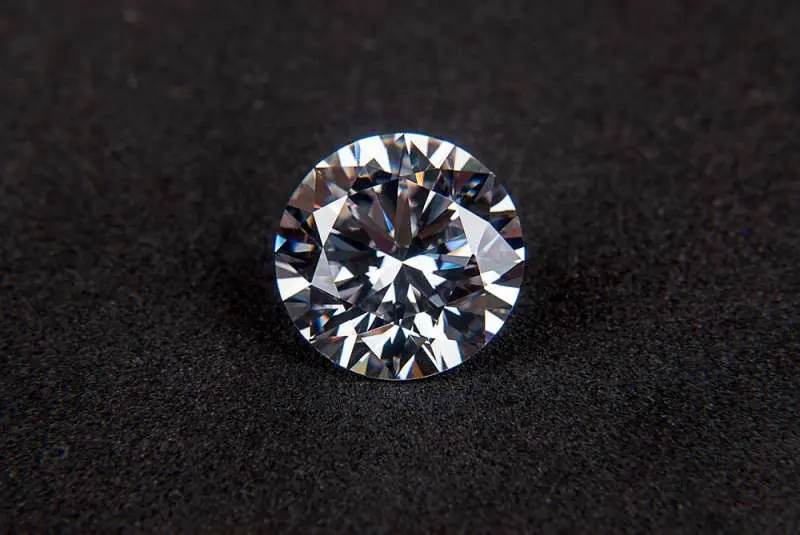 “Look, it’s a piece of bone!” I knelt and picked it up, then another, and another of the pale fragments on the ground. It was a pleasant, sunny autumn day, perfect for an afternoon of casual fossil hunting with my boyfriend. As we followed the bone fragments, I almost stepped on a large, pale fossil just barely sticking out of the ground. It really was quite an extraordinary find – the fossils were preserved surprisingly well, and there were several others that we found just behind the bone I had nearly stepped on. Then there was something odd behind the bones . . . it was hard to tell at first, but more digging revealed that it was a small, wooden box! I was baffled, until my boyfriend opened the little treasure box, revealing a diamond ring. He offered our “rare find” to me, and I accepted it. Getting to dig up my own diamond like this reminded me of where diamonds come from, and how incredible they are.
“Look, it’s a piece of bone!” I knelt and picked it up, then another, and another of the pale fragments on the ground. It was a pleasant, sunny autumn day, perfect for an afternoon of casual fossil hunting with my boyfriend. As we followed the bone fragments, I almost stepped on a large, pale fossil just barely sticking out of the ground. It really was quite an extraordinary find – the fossils were preserved surprisingly well, and there were several others that we found just behind the bone I had nearly stepped on. Then there was something odd behind the bones . . . it was hard to tell at first, but more digging revealed that it was a small, wooden box! I was baffled, until my boyfriend opened the little treasure box, revealing a diamond ring. He offered our “rare find” to me, and I accepted it. Getting to dig up my own diamond like this reminded me of where diamonds come from, and how incredible they are.
Every diamond actually does have to be “dug up”, but human mining abilities can only sift through diamonds that have already been brought close to the surface. Diamonds start out at least ninety miles below Earth’s surface – much deeper than people can even hope to mine. To put this into perspective, the deepest part of the ocean is almost seven miles deep and the area where diamonds form is about thirteen times deeper. Shallower than this, the temperatures and pressures are not enough for diamonds, and they break down into graphite, like black pencil lead. Much lower than the diamond zone, the temperatures and pressures are too much, and the diamond breaks down. Diamonds were probably formed around the time God first created land, about six thousand years ago, sitting below the “basement rock” that was the main foundation for land before the global flood.
For a while after creation, these valuable gems were likely still out of reach, well below Earth’s surface. The volcanic activity during the global, catastrophic flood (and for a while after the flood) provided just the right way for diamonds to travel up to the surface. Today, these precious stones are found in very special rock sections of either kimberlite or lamproite, formed into deep, narrow “pipes”. These rocks are basically a type of volcanic rock with some interesting extra minerals that the magma (underground lava) picked up on its way to the surface. Diamonds rode this stream of magma up through Earth’s surface. As mentioned before, these gems will turn into pencil lead if they’re not in their special diamond zone. To get diamonds up to the surface without breaking down, they need to move very quickly. They needed to travel all ninety miles in just seven to twenty hours. Magma moving this fast would create an eruption much bigger than Mount St. Helens and unlike anything in our world today. We know that something catastrophic must have brought diamonds close enough to dig.
Diamonds are incredible gem stones that point to creation and the catastrophic flood, showing remarkable evidence that the Earth is young (only about six thousand years old). Their dramatic entrance is only part of the story. Carbon-14 is a radioactive chemical that breaks down and would become undetectable after about fifty-thousand years. Traditionally, diamonds are thought to be one to three billion years old, but Carbon-14 could not last that long. These valued stones confirm what the Bible says about the history and age of the earth.
The journey of a diamond coming up to the surface is a beautiful thing to think about. Valuable gems start out in the depths of the earth where it’s dark and extremely hot. Literally tons of pressure are pushing all around it. They need to be picked up by a flow of magma, getting ready to explode toward the surface. Those diamonds need to be carried fast enough so that they don’t break down. To become jewelry, these gem stones must be cut and shaped, even after all they’ve traveled through, because that cutting and shaping will reveal the deep beauty under the surface. All that these diamonds travel through keeps them pure, brilliant, sharp, and valuable. One of the most beautiful things about a diamond is the way it reflects light. May your life be like a diamond, made better through the pressures and changes over the years, kept in just the right place at just the right time (by your Maker), and cut away so that you may brilliantly reflect the Light of the World – Jesus.
©December 2016, Sara J. Bruegel
References:
- Snelling, Dr. Andrew. Dazzling Diamonds by Special Delivery. April, 2015. Answers Magazine. Answers in Genesis. Last accessed 12-16-16. https://answersingenesis.org/geology/rocks-and-minerals/dazzling-diamonds-special-delivery/
- Snelling, Dr. Andrew. Diamonds—Evidence of Explosive Geological Processes. Originally published in Creation 16, no 1 (December 1993): 42-45. Last accessed 12-16-16 https://answersingenesis.org/geology/rocks-and-minerals/diamonds-evidence-of-explosive-geological-processes/






So you actually think real scientists are either stupid or are lying about the great age of diamonds (and this planet)?
No. Most are probably just deceived, ignorant, using fallacious reasoning, misinterpreting, or simply never thought seriously about it.
Which is an equally bizarre belief to hold about the scientific community.
Especially since young earth creationist apologists who possess them are forever highlighting their own scientific qualifications such as the holding of a PhD. Yet they want to tell us that ‘other’ scientists possessing the same qualifications are all deceived, ignorant, using fallacious reasoning, misinterpreting, or simply have never thought seriously about what they believe the available evidence points to about the past.
Well, sorry you feel that way. Have a good night!